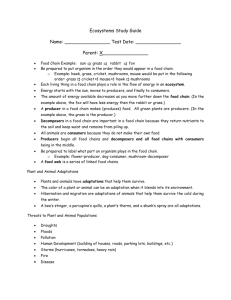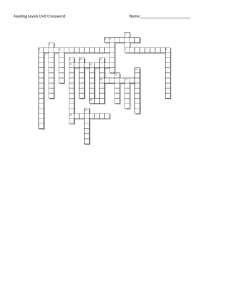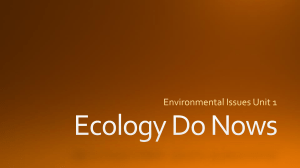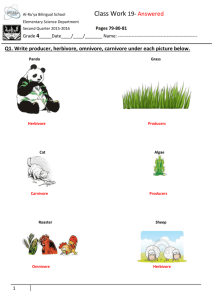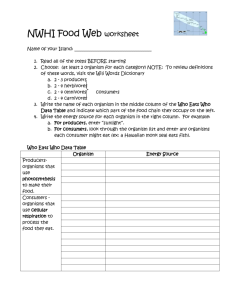organism that makes its own food by photosynthesis
advertisement
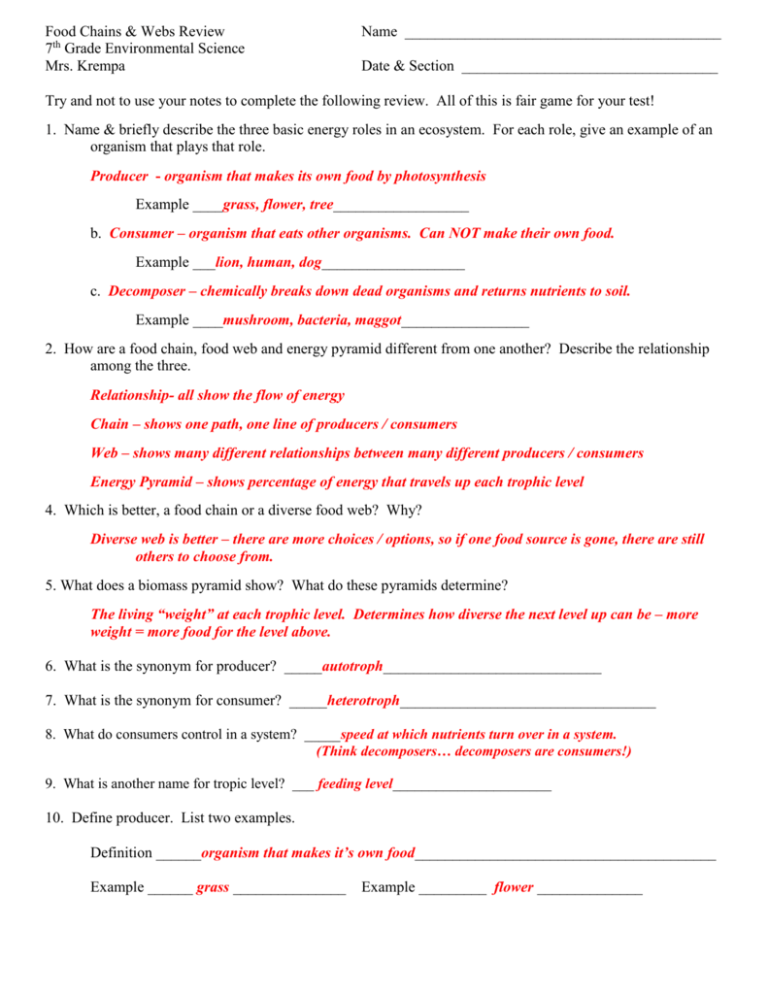
Food Chains & Webs Review 7th Grade Environmental Science Mrs. Krempa Name __________________________________________ Date & Section __________________________________ Try and not to use your notes to complete the following review. All of this is fair game for your test! 1. Name & briefly describe the three basic energy roles in an ecosystem. For each role, give an example of an organism that plays that role. Producer - organism that makes its own food by photosynthesis Example ____grass, flower, tree__________________ b. Consumer – organism that eats other organisms. Can NOT make their own food. Example ___lion, human, dog___________________ c. Decomposer – chemically breaks down dead organisms and returns nutrients to soil. Example ____mushroom, bacteria, maggot_________________ 2. How are a food chain, food web and energy pyramid different from one another? Describe the relationship among the three. Relationship- all show the flow of energy Chain – shows one path, one line of producers / consumers Web – shows many different relationships between many different producers / consumers Energy Pyramid – shows percentage of energy that travels up each trophic level 4. Which is better, a food chain or a diverse food web? Why? Diverse web is better – there are more choices / options, so if one food source is gone, there are still others to choose from. 5. What does a biomass pyramid show? What do these pyramids determine? The living “weight” at each trophic level. Determines how diverse the next level up can be – more weight = more food for the level above. 6. What is the synonym for producer? _____autotroph_____________________________ 7. What is the synonym for consumer? _____heterotroph__________________________________ 8. What do consumers control in a system? _____speed at which nutrients turn over in a system. (Think decomposers… decomposers are consumers!) 9. What is another name for tropic level? ___ feeding level______________________ 10. Define producer. List two examples. Definition ______organism that makes it’s own food________________________________________ Example ______ grass _______________ Example _________ flower ______________ 11. Define primary consumer. List two examples. Definition ______consumer that directly eats a producer. Herbivore. _____________________ Example ______ moo cow____________ Example ________ rabbit_______________ 12. Define secondary consumer. List two examples. Definition _____ consumer that eats a primary consumer. Omnivore or carnivore.________________ Example _____frog, shrew, mouse______ Example ______lizard, snake_________________ 13. Define tertiary consumer. List two examples. Definition ______ consumer that eats a primary or secondary consumer. Omnivore or carnivore. Example ____Lion______________ Example _______Hawk_________________ 14. What is detritus? _____”leaf litter”, waste, plant and animal remains on the forest floor ___________________detritus = decomposer “food”______________________________ 15. What is the name of the process plants use to make their own food? ____ photosynthesis ________ 16. List two examples of the following consumers… herbivore ______moo cow__________ Carnivore lions, tigers, sharks, Eagles ______deer, Parrott_______ Omnivore human, bear, shrew, mouse ________________________________ Scavenger Coyote, goat, Robin, Blue Jay hyena, vulture, raccoon, crow, fox Chicken 16. Fill in the Energy Pyramid below. Include numbers (calorie or percent), an organism at each level and label each level as producer, primary consumer, secondary consumer or tertiary consumer. hawk 2.967 cal 29.67 cal 296.7 cal. 2,967 calories Tertiary Consumer Secondary Consumer snake Primary Consumer grasshopper producer Grass 24. Use the food web below to answer the following questions. a. List two primary consumers from this web. Caterpillar, Rabbit, Squirrel, Mouse b. List two secondary consumers from this web. Thrush, Hawk, Fox, Weasel c. List two tertiary consumers from this web. Hawk, Fox d. List one organism that could be placed at more than one level in this food web. Identify what levels they could be on. Organism: Hawk Levels: secondary when it eats Rabbit, tertiary when it eats Thrush that eats caterpillar then grass Organism: Fox Levels: secondary when it eats Rabbit, tertiary when it eats mouse that eats caterpillar then grass There are other examples… ! e. What potential consequences are there if the mouse were removed from this food web? Weasel would die (no food), Fox would go down (two less food sources – weasel & mouse), Hawk would go down (1 less food source), acorn & grass would go up (mouse not eating it), everything that eats grass and acorns would go up (more food) f. List two pairs of organisms that may compete with each other. What would they compete for? Pair Hawk & Fox Compete for Rabbit, Squirrels & Mice Pair Rabbit & Squirrel Compete for Grass & Acorns Thrush Acor n 25. Draw two chains from the web above. Label each organism as producer, primary consumer, secondary consumer or tertiary consumer. 1. Grass Rabbit Fox 2. Grass Caterpillar Thrush Hawk

